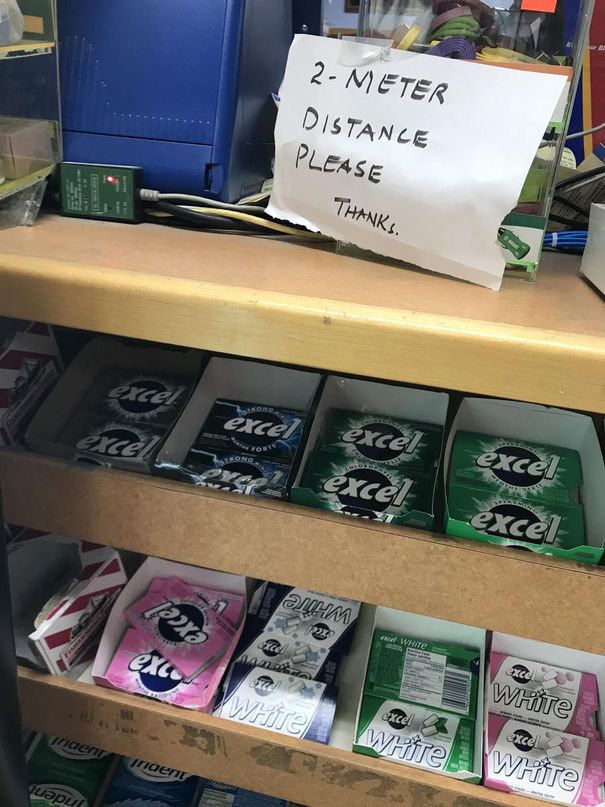When the Excel package arrived in the mail, it dawned on me: I hadn’t chewed gum in almost two years.
The pandemic created winners and losers in the candy aisle. French fries, ice cream and cookies were popular delicacies in a housewife world, but the freshness of mint did not carry the same prestige. At home, there was always a toothbrush within walking distance. In a virtual meeting, coffee breath was not a problem. In public, the masks kept their egg salad sandwich a secret.
Before the pandemic, chewing gum was a $ 359 million a year (US) industry in Canada. In 2020, sales fell to $ 293 million, a decrease of 18 percent, according to market research firm Euromonitor International. Since half of gum chewing occurs outside the home, a world with limited social interaction presented a significant disruption to the industry.
At the edge of the financial district, Sadia Khakashan is behind a sheet of plastic, separating her from an inventory of cough drops, candy, and phone accessories at Friends Convenience and Grocery. It’s lunchtime, but the old bustle of your store is missing. Many office workers used to pick up a pack of gum on their lunch breaks, especially smokers and coffee drinkers. And there were always the students who forgot to brush their teeth in the morning. But now chewing gum, like the business itself, is very slow.
Chewing gum is an impulse purchase. “One of the biggest barriers for people buying gum is that they just didn’t think about it,” says Mars Wrigley Canada general manager Chantal Templeton.
So as the country began to reopen this fall, the company began shipping a packet of Excel gum to 500,000 Canadians, “to remind people how nice it is to have fresh breath,” says Templeton.
Mike Goodman, a leader in the gum, cough and candy category with Mondelez Canada (the makers of Trident and Dentyne), says that gum consumption is so closely related to on-the-go activities that sales moved in tandem with restrictions , decreasing during closure and improving during periods of relaxed rules. Consumer motivation also changed.
There was “a slight decrease in the desire to freshen their breath,” he writes, but more people chewed for a snack, a reward, or a stress reliever. At Mars Wrigley, that meant the “fun and fruity” gum performed slightly better than the mint.
Templeton says the pandemic is probably the biggest challenge the industry has ever faced. “We’ve never been through something like this,” he says. “In hindsight it all makes logical sense, but it was really interesting and surprising to see how quickly people’s behavior changed.”
Chewing gum, or its approximation, has always been around, with the ancient Greeks, Mayans, and other indigenous peoples chewing on its local forms of tree resin. Chewing gum was first produced commercially in the mid-19th century.
“The ladies of New York have adopted some strange customs that seem to make them a peculiar people,” wrote the Toronto Globe in 1860. “One is the almost universal habit of chewing gum, as men chew tobacco. It is used in the high and low life, by the schoolgirl, the maid and the matron. “
The consumption, they said, was “immense.”
Sending gum to the masses is not a new idea. During World War I, William Wrigley Jr. mailed three sticks to every American listed in phone books to help boost sales. Back then, the industry was booming. The company built the “largest and finest gumball factory” in the British Empire on Toronto’s Carlaw Avenue in 1916.
Chewing gum was so popular in Queen’s Park in the 1920s that the housekeeper banned its sale and chewing. In their advertisements, the gum barons touted its benefits: digestive relief, romantic possibilities, soothing throat properties after smoking. In the 1960s, when smoking was linked to lung cancer, chewing gum sales increased. They continued to rise until the late 1960s with postwar growth reaching into the pockets of Baby Boomer kids.
But as anyone who has chewed Juicy Fruit can tell you, nothing lasts forever. The Wrigley War Factory is now a condominium; the company closed its remaining Toronto factory in 2016 due to declining sales.
In the few years leading up to the pandemic, gum sales in Canada declined by about two percent each year. Mars Wrigley’s Templeton says one of the challenges is that young people don’t chew at the same rate as previous generations.
She is optimistic that the industry will recover.
This past spring, a extra gum ad – a Mars Wrigley brand – set in the “not-too-distant future” showed people escaping from their dark, toilet-paper-filled homes as a radio DJ proclaims that it is safe to return to the world. Graying masses ditch video calls and old pizza boxes as Céline Dion’s “It’s All Coming Back to Me Now” grows. The mood is exultant. People chew gum before kissing. “We could all use a fresh start,” says the motto.
The announcement touched a nerve, but that imagined future, that moment of celebration, has not been realized. Vaccines arrived, but also variants and doubts about vaccines. The full-scale return to the office is still looming, and the chewing gum industry is counting on the resurgence of old social graces.
“We have a real optimism that as people return to a more normal version of life,” says Templeton, “habits like this will come back with them.”
Freshening your breath is the number one reason people chew gum, Templeton says. Other reasons include boredom, better concentration, and a “clean mouth feeling.”
Those reasons become more relevant as the partnership opens. But even in a restricted world, chewing gum is still helpful in fighting masked breath.
“Chewing gum can make a big difference there.”
JOIN THE CONVERSATION
Reference-www.thestar.com
